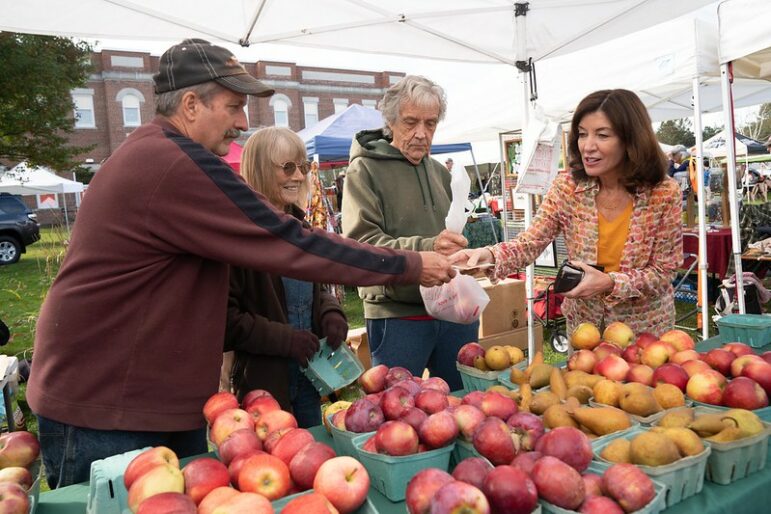“Without Hochul’s swift action, New York State honeybee colonies will continue to log record losses, and 40-60 percent of the state’s native bees and other pollinators will remain at risk of disappearing.”

Don Pollard/Office of Governor Kathy Hochul
Gov. Kathy Hochul buying apples in 2021.Although better known for other milestones like the start of school or the beginning of fall, September is also National Honey Month. This year, it also fittingly held Rosh Hashanah, when we dipped apples in honey in hopes of securing a sweet new year. But times are not so sweet for New York’s pollinators due to widespread neonicotinoid or “neonic” pesticide pollution. This pollution also threatens the state’s ecosystems, New York City’s celebrated water supply, and the health of New Yorkers themselves.
Gov. Kathy Hochul has the opportunity to build on her environmental legacy by signing the Birds and Bees Protection Act—a first-in-the-nation bill to restrict widespread neonic pollution. Without Hochul’s swift action, New York State honeybee colonies will continue to log record losses, and 40-60 percent of the state’s native bees and other pollinators will remain at risk of disappearing. Overwhelming scientific evidence continues to point at neonics—the most widely used insecticides in the United States—as a lead culprit for mass pollinator losses.
Neonics’ harms, however, reach well beyond bees. In May, the U.S. Environmental Protection Agency made the shocking and unprecedented finding that neonics are likely sending 200-plus species toward extinction—11 percent of the entire endangered species list. Like honeybees, these vulnerable species are canaries in the coalmine for much broader biodiversity and health harms that we haven’t seen since the era of Silent Spring and DDT.
Among the most potent insecticides ever created, neonics have made U.S. agriculture nearly 50-times more harmful to insect life and contaminate whole ecosystems. They are easily carried long distances in rainwater to leach into new soil, plant life, and water supplies. Neonic buildup from year-over-year use have made the pesticides pervasive environmental contaminants, especially in New York water. Because only advanced filtration removes neonics from water, vast neonic pollution poses particular concerns for New York City’s famously unfiltered water supply.
Extensive contamination can also be seen in New Yorkers’ bodies. Recent testing finds neonics in more then 95 percent of pregnant women tested in New York and four other states—raising alarms from health experts concerned about neonics’ links to birth defects and autism-like symptoms in prenatally exposed children and a host of neurological and hormonal harms in adults.
As new Harvard research shows, pollinator losses also harm New Yorkers by depressing production of fruits and vegetables, making fresh produce less available and more expensive, especially to already food-challenged families. In the U.S., yields of top state crops like apples are already “pollinator limited,” as honey production continues to fall—possibly cramping future Rosh Hashanah plans. Widespread neonic pollution has also been linked to the mass disappearance of birds, another important pollinator. Indeed, neonic pollution is emerging as one of the greatest drivers of biodiversity loss and a growing concern for our own health.
Gov. Hochul has long been an environmental champion, supporting the Environmental Protection Fund and the Clean Water, Clean Air, and Green Jobs Environmental Bond Act, which both invest in the future of New York State. With New York City having just celebrated a successful Climate Week, now is the time to act to protect the state’s pollinators and environment.
Curbing needless neonic use is extremely popular with New Yorkers, with the vast majority in support. Likewise, the Birds and Bees Protection Act enjoyed broad and bipartisan backing in passing the legislature, with Assembly Speaker Carl Heastie in vocal support of its commonsense protections for pollinators and public health. The targeted and science-based provisions of the bill would eliminate 80-90 percent of the neonics polluting the state’s environment every year by prohibiting only uses that extensive Cornell University research finds are unnecessary or easily replaced with safer alternatives.
Signing the bill would be a chance for Gov. Hochul to once again make New York a national environmental and public health leader—but the state would be in good company globally. Europe, Québec, and Ontario have all long moved on from the neonic uses targeted by the bill without issue.
For example, Québec phased out neonic coatings on corn and soybean seeds with no evidence of crop loss or switching to more harmful environmental practices or chemicals. Meanwhile, ongoing Cornell University research continues to demonstrate the uselessness of these coatings in New York and that nonchemical practices, like cover cropping, may better reduce the risks the coatings were designed to treat.
While the chemical industry continues to follow its usual playbook, sewing misinformation and doubt, the science on the harms that needless neonic use inflicts couldn’t be clearer. That’s why nearly 350 New York farms, businesses, and organizations have called upon Gov. Hochul to follow through on her stated commitment to pollinators and sign the bill this month. Then bees, birds, and New Yorkers all would have something to celebrate this September.
Now wouldn’t that be sweet?
Dan Raichel is the acting director of the Pollinator Initiative at NRDC (Natural Resources Defense Council) and Richard Schrader is New York legislative and policy director for NRDC based in New York, NY.








